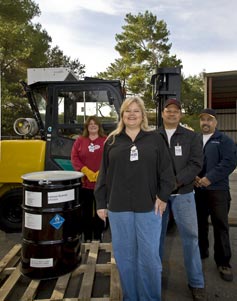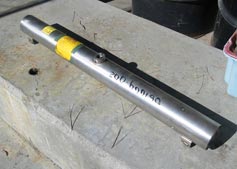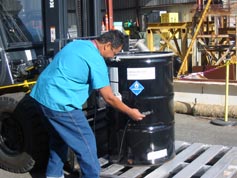
Handy Links
SLAC News Center
SLAC Today
- Subscribe
- Archives: Feb 2006-May 20, 2011
- Archives: May 23, 2011 and later
- Submit Feedback or Story Ideas
- About SLAC Today
SLAC News
Lab News
- Interactions
- Lightsources.org
- ILC NewsLine
- Int'l Science Grid This Week
- Fermilab Today
- Berkeley Lab News
- @brookhaven TODAY
- DOE Pulse
- CERN Courier
- DESY inForm
- US / LHC
SLAC Links
- Emergency
- Safety
- Policy Repository
- Site Entry Form

- Site Maps
- M & O Review
- Computing Status & Calendar
- SLAC Colloquium
- SLACspeak
- SLACspace
- SLAC Logo
- Café Menu
- Flea Market
- Web E-mail
- Marguerite Shuttle
- Discount Commuter Passes
-
Award Reporting Form
- SPIRES
- SciDoc
- Activity Groups
- Library
Stanford
Around the Bay
Safe 08: Safety Extends Beyond the Fenceline
Sometimes SLAC safety needs to extend beyond the lab grounds. This fall, the SLAC National Accelerator Laboratory Environment, Safety and Health Division contracted an outside vendor to safely treat and dispose of a cylinder of lithium hydride. The highly reactive solid can be treated and disposed of only at Environmental Protection Agency-permitted facilities, and it was up to SLAC Radiation Protection employees to find an authorized vendor with the expertise to dispose of the material appropriately after taking it off the SLAC campus.
When experiments require hazardous materials, they also require someone to manage any by-products. Radioactive Waste Group Leader Olga Ligeti manages the safe and proper handling and disposal of radioactive and mixed wastes for SLAC. The lithium hydride presented Ligeti with a unique challenge: the chemical is hygroscopic, meaning it reacts violently with water or moisture in air. Even a small amount of air will cause it to react, releasing hydrogen gas, which can ignite or possibly cause an explosion.
SLAC physicists used the lithium hydride years ago in an experiment to absorb low-energy photons preferentially, allowing high-energy photons through, a process called photon beam hardening. The chemical remained in a hermetically sealed cylinder under an inert atmosphere during its stay at SLAC. The cylinder, about four feet long and weighing less than twenty five pounds, could not be opened without strong cutting tools. However, since the material had been in the cylinder for several decades, internal erosion over the years could make the container fragile. From a safety standpoint, SLAC Radiation Protection Radioactive Waste group didn't want to risk keeping the lithium hydride in the cylinder any longer.
"The risk reduction is in handling it in a timely fashion," Ligeti said. "By not doing it on site we eliminated time delays." In addition to the need to meet EPA requirements, a permit from the state of California is required to treat the lithium hydride. State permits take a long time to prepare and even more time to obtain authorization. So rather than wait, Ligeti and her team began seeking outside contractors to take the cylinder and treat it at an outside facility.
But finding a suitable outside vendor proved to be a safety challenge as well. Ligeti sent out a call to possible vendors and asked them to respond with an outline of their plans for handling the substance. Radioactive lithium hydride is not a common waste byproduct, and none of the vendors she called had handled it before. As a trained specialist in the laws and regulations that determine how such a chemical needs to be handled, Ligeti was required to evaluate each proposal and determine whether it met guidelines set by the state, the EPA and the Department of Transportation.
"It's more than an ethical issue; it's a liability issue," Ligeti said. "We would never send something to a vendor knowing they would handle it incorrectly." Many waste streams, she said, do not have a path for disposal. For this reason, it is extremely important that experimenters consult with SLAC disposal groups before producing research waste, to determine how those wastes will be managed.
Last April, Ligeti found what she was seeking for the lithium hydride disposal: a subsidiary of Energy Solutions called Duratek presented a strong plan for handling the substance and met the necessary requirements. The company would have to move the lithium hydride all the way to Tennessee, where they planned to open the container in a sealed environment. The group would de-activate the lithium hydride in a controlled manner, siphoning off the hydrogen gas as it was produced. Ligeti had to coordinate the contractual paperwork for moving the container, and work with a Duratek broker to safely seal it up for transport.
Health Physics Technicians Wendel Agot and Jerri Schoff performed characterization analysis and modeling on the cylinder to determine its radioactivity level. Radioactive Waste Coordinator Joseph Cristy performed the DOT classification of the waste. The very low levels of radiation were outweighed by the chemical hazard presented by the lithium hydride. Radioactive Waste Technicians Emilio Castro and James Dayton helped safely prepare the waste for transportation. This included adding the packing material (similar to cat litter) to absorb shock and keep the cylinder centered in the shipping drum, which met very specific DOT requirements. While it looks like a typical oil drum, the specialized container is made of thicker material and has undergone strength testing required by the DOT. The Duratek broker checked off all safety and packaging preparations before the drum was loaded for transportation by Castro and Dayton.
Duratek will complete the treatment of the lithium hydride by September 2009. State regulations permitted Duratek to take only this one small sample of lithium hydride, but the company may now apply for certification to handle larger amounts of similar substances. In the future, this could provide SLAC and other facilities with an available vendor for even faster disposal of similar mixed wastes.
Hazardous materials are a regular by-product of the work done at SLAC, and the Waste Management group performs an essential function in mitigating the risks posed by those materials. They are working to keep SLAC safe, even when that means looking beyond the fenceline.
—Calla Cofield
SLAC Today, December 15, 2008


